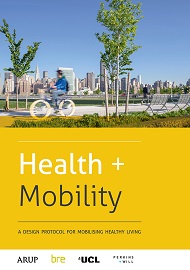Transport design and health
In October 2016, a report published by Arup, BRE, University College London and AREA Research proposed that taking a new approach to designing city streets and other transport infrastructure could have a significant impact on public physical and mental health.
The report’s guidance comes as the NHS is placing increasing emphasis on wellbeing and prevention to help relieve pressure on its services. The number of people suffering chronic diseases, such as stroke, asthma and diabetes, is increasing, posing significant cost burdens on the NHS. The cost of treating diabetes-related conditions alone in the UK was £10 billion in 2011-2012.
The report, 'Health + Mobility: A design protocol for mobilising healthy living', aims to provide civic leaders, city planners and architects with a guidance protocol that can be applied in any urban setting. By taking a more holistic approach to transport design, cities can be helped to identify the health issues that can be influenced.
The research team of public health specialists and built environment professionals found that something as simple as the design of streets, pathways and other networks could have a significant impact on walking, cycling and other physical activities.
The Liverpool Knowledge Quarter in the UK was one of two locations chosen to test the transport design protocol in a real life setting.
The protocol’s application to the Liverpool site highlighted a range of measures that could be implemented to improve underlying health issues in the area. This included reducing the number of wide and busy roads, efficient transport planning and road layout changes and creating more attractive pedestrian and cycling networks.
These changes could facilitate a better street life, improve air quality and encourage people to be more physically active, and they have the potential to help the wider city of Liverpool move towards a healthier environment.
Helen Pineo, associate director for cities at BRE and one of the authors of the guidance, said: “The challenges are so great that they cannot be resolved by health services alone. Planners and designers all have a part to play in promoting health and wellbeing in our cities, and this protocol gives them the tools to create healthier places, without requiring a knowledge of the specialist language of the health sector.”
Professor Nick Tyler from University College London Department of Civil, Environmental and Geomatic Engineering’s Centre for Transport Studies said: “The way we move around the built environment can affect our health in a variety of ways – physically, sensorially and psychologically. By designing the environment to give positive health outcomes we can make a huge difference to people’s quality of life and healthcare needs.
The report, 'Health + Mobility: A design protocol for mobilising healthy living', is available free to download here.
[edit] Related articles on Designing Buildings
- BRE articles on Designing Buildings Wiki.
- Car park.
- Compliant public transport node.
- Cycling and walking plan.
- Data-driven mobility.
- ECA backs joint rail electrification statement.
- Highways in England and Wales.
- Integrated transport system.
- Safe pedestrian route.
- Sustainable transport.
- Road traffic management.
- RORO shipping.
- The history of the dimensions and design of roads, streets and carriageways.
- Traffic and transport.
- Traffic engineering.
- Transport assessment.
- Travel plan.
Featured articles and news
Homes England creates largest housing-led site in the North
Successful, 34 hectare land acquisition with the residential allocation now completed.
Scottish apprenticeship training proposals
General support although better accountability and transparency is sought.
The history of building regulations
A story of belated action in response to crisis.
Moisture, fire safety and emerging trends in living walls
How wet is your wall?
Current policy explained and newly published consultation by the UK and Welsh Governments.
British architecture 1919–39. Book review.
Conservation of listed prefabs in Moseley.
Energy industry calls for urgent reform.
Heritage staff wellbeing at work survey.
A five minute introduction.
50th Golden anniversary ECA Edmundson apprentice award
Showcasing the very best electrotechnical and engineering services for half a century.
Welsh government consults on HRBs and reg changes
Seeking feedback on a new regulatory regime and a broad range of issues.
CIOB Client Guide (2nd edition) March 2025
Free download covering statutory dutyholder roles under the Building Safety Act and much more.
Minister quizzed, as responsibility transfers to MHCLG and BSR publishes new building control guidance.
UK environmental regulations reform 2025
Amid wider new approaches to ensure regulators and regulation support growth.
BSRIA Statutory Compliance Inspection Checklist
BG80/2025 now significantly updated to include requirements related to important changes in legislation.
























